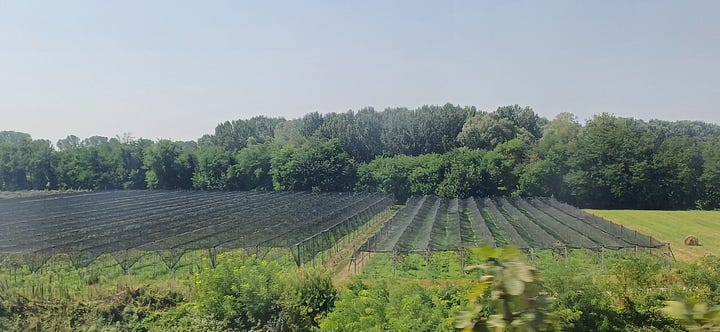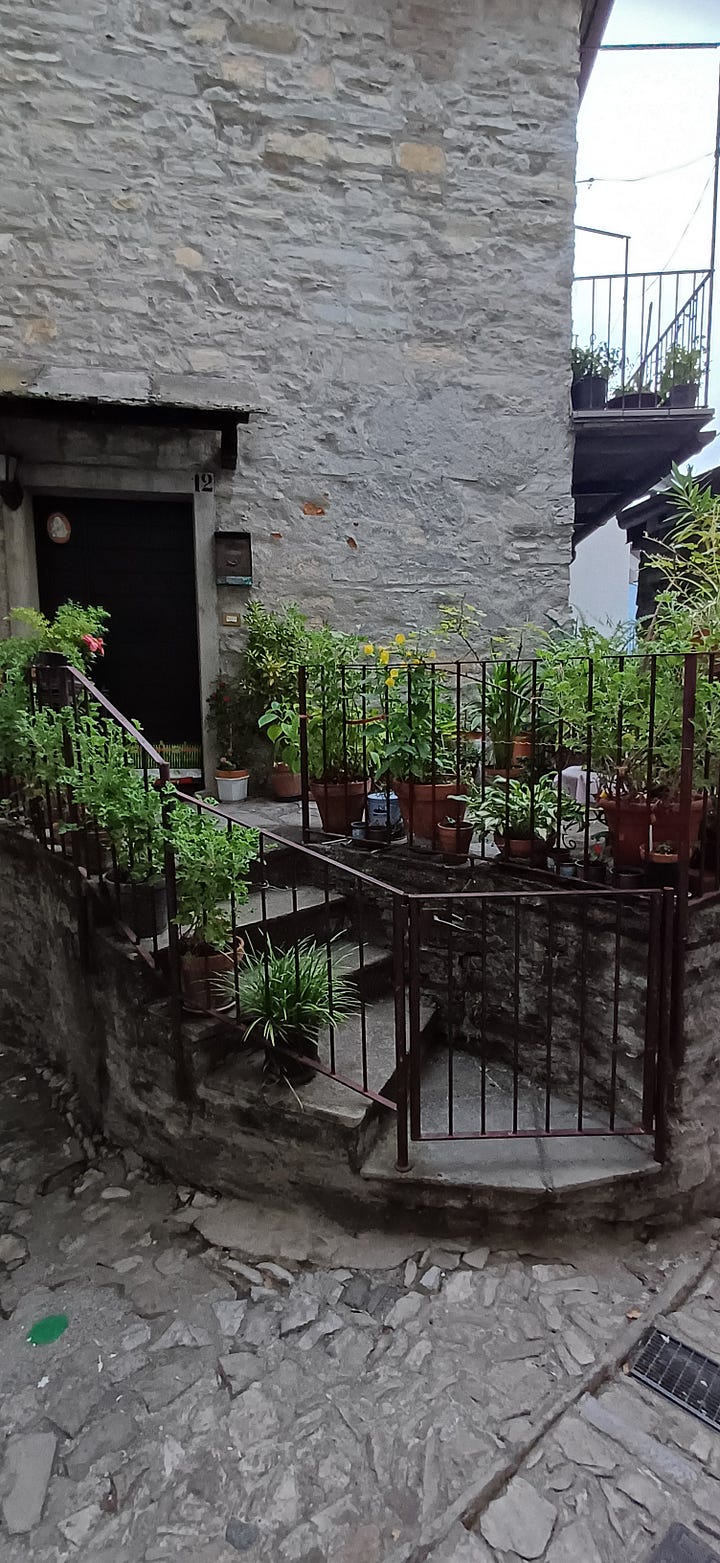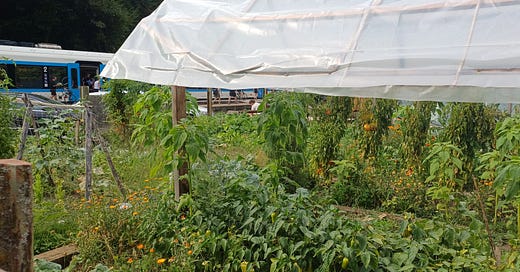When feeling a little lost in a situation I find it useful to remove myself from it this generally takes the form of a long walk in the Yorkshire moors to clear my mind. During this season Picked at Dawn has had two distinct tracks running parallel in my day-to-day life both of which need managing and have different customers. The plug plant and propagation side of things seem to be heading in the right direction. Whilst the challenges of cultivating a large large-scale feild growing operation continue through issues of a change in climate, soil conditions and pests. This has led me to question how and why I grow the way I do. In a bid to remove myself from this situation, I went on a longer ramble than usual. This month’s article will take us out of my field in North Yorkshire UK and open my eyes and hopefully my mind to a broader range of the use of growing spaces. So pack your rucksack and swap those wellies for flip-flops we are off on an Inter-rail adventure further afield.
The journey began In Berlin and then onto Munich but for the sake of keeping things relevant and not dragging you all into the Beerhalls of Bavaria we will board a highspeed train through the Austrian Alps which even impressed at a fleeting glance from the train window, an area now with retrospect that I wish I had accounted for more time to visit as I am sure judging by the hanging bedding plants cascading from the balcony of houses I would have found some people very enthusiastic about plants. Onward we now find ourselves in our next scheduled stop for a few days in Slovenia.
Slovenia
After a refreshing dip in Lake Bled following a long day’s travel a final little trundle along the tracks through train stations was where my first impressions of this region began to develop. Every train station had a small garden set to one side and a bar to the other, for someone who enjoys a cold beverage after a day in the dirt this did look promising!
We arrived in the Soca Valley, a landscape dominated by a vast valley housing low-lying villages held in the hands of the far-reaching Juan Alps. As we wandered and bussed around the villages of the valley, I noted nearly every single house had a productive space growing, seemingly the most consistent crops being tomatoes grown under varying-sized makeshift polytunnels alongside courgettes and the seasonal flowers of choice seemed to be Zinnias and Asters. As I headed to the village edges the surrounding flatlands were what I would describe in modern farming standards micro-farms, houses had 3-10 acres maximum much of the land seemingly unploughed growing blocks of herbal lay, sectioned into smaller areas by electric fence grazing a handful of cattle. then there was the seemingly randomly placed veg patch normally around 10mtrs square, to provide the family with a good proportion of their veggie consumption, alongside the most beautifully stacked log stores I have seen.



These were not mass farms these were people using space well for thier own needs, I suppose this way of growing and farming may have developed from living in the foothills of the Juan Alps I imagined a conversation I would have had with myself if I Farmed there “ this is the only land available because those mountains are going nowhere so this land has to work”. Whilst in Soca I spoke to 2 people both of different generations the first Rodge gifted us tomatoes and peppers from his garden and spoke of his love for the region where he has lived for over 60 years, how he loves nature and seeing how the landscape changes with the seasons, and his disappointment that the evenings of 1mtr winter snowfall he remembers as a child now falls as a couple of centimetres which has melted away by lunchtime. The second was Tina I would guess in her mid-30s, who was intrigued by what I did for a living and informed me that many younger Solvinians “have no interest in growing their own or farming” As we move on from Soca, I truly hope that generational migration and the climate won’t affect this region too much and some people continue to grow and farm in this charming, peaceful rustic landscape.
Italy
After a walk across the border into Italy, aboard another train, onward we sped to a quick stopover to wander the streets of Venice. I knew enough about the bustling tourist city on the water to realise I wasn’t going to see a vast Italian vista here but I did find small amounts of greenery in the wall crack weeds trying their best to add a bit of natural decoration to the historic streets. Heading away from the historic vibes of the city aboard another train, from the carriage window I could see there was a significant change in farming. Cultivated fields grew in scale into blocks of vines, fruit trees and maize.


We disembarked at the tip of Lake Como, a place noted as the destination of the holidaying Hollywood set. You might find this stop a strange choice for a flower farmer who knows more about plants than the lives of the rich and famous but I always wanted to visit an Italian lake so here we are. I must admit I was surprised at how much pleasure this has brought me, some of the gardens around the lake with banks of hydrangeas growing in the shade of palms and traditional Italian fingers of conifer and evergreen Magnolia. Here in abundance is a crop which I have tried numerous times to grow in my cold clay feild, Jasmine grows so quickly that the neet and tidy secature happy gardeners of the lake haven’t had time to clip yet, It wasn’t open countryside which I feel at home in but, this area had something which got to me.



Now you can imagine as a wandering flower farmer I had no connections to snoop around the large private gardens of the rich and famous, although I did try to tip George Clooney a wink through his window (you gotta try!) . There is one person I do have a connection with in Como though, Olga, from Olgas Flower Farm. We first spoke through the European Growers Association, in 2021, and have shared messages and watched each other grow virtually since, and this was too good an opportunity too miss, so off I popped to visit her on her flower farm.
Olgas Flower Farm


Flower farming can be a tough and Isolating job sometimes, it can be hard for those who are not doing this as an occupation to appreciate the ups and downs of working with nature. I have for years followed Olga and a couple of other growers in European flower growers who I feel a connection to closely on social media. I wondered if we felt the same challenges well having met Olga turns out the issues, and pleasures of this Italian grower are very similar to those of this UK-based grower.
Firstly a little bit on Olga, she established her flower business alongside her mother on her family’s old plant nursery site in 2017. Her favourite flowers are bearded Iris and Narcissus. She took her first steps into growing seasonal local flowers through memories of picking daffodils as a child and as an adult developing a growing desire to plant a more diverse range of daffodils to pick from which then led to the formation of Olgas Flower Farm. She grows on roughly half an acre with 3 large polytunnels. 1 used for propagation and storage, 1 for both propagation and planting and a shade tunnel housing a beautiful section of Hydrangea. The beds outside grow a mix of annuals, perennials and bulbs with a surrounding hedge of mixed shrubs which Olga uses in her work.
Olga supplies florists in Milan with her flowers weekly although not in high summer as apparently Milan becomes a ghost town as a big part of the population moves out to the hills (who knew, not me). Alongside wholesale Olaga also works with private clients on garden and floral design. Running workshops and doing weddings during the cooler months either side of summer. So there is a lot of petals that make up their flowery business.




Without prompt from me and my woes, Olga spoke honestly describing a very difficult growing season. Consisting of a wet Spring, a plague of Slugs and since May extreme drought and heat which resulted in a do not work outdoors warning from the Italian government. We discussed other issues regarding fair pricing for a perishable product that takes a lot of care and knowledge to grow well. The climate was a big point of similarity as we both agreed certain plants were becoming more hassle than they were worth to grow nowadays, and the sad demise we had noted in both countries at certain varieties of trees notably Prunus dying off.
Having said all that I saw in Olga a determination to continue, through her passion for plants, and how she like me is also planning to future-proof her flowers from climate change by growing more shrubs and perennials. When you work as a full-time flower grower or in nature every day I am convinced we all share a deep understanding of what is happening, but through our passion for growing, we just find a way to adapt what we do to continue. If you ever find yourself in Como and it coincides with one of Olga’s workshops I recommend you book into one and meet her I am sure you'll be inspired by her passion for plants.
Small spaces and Terraced gardens.
I thought originally that I would want to join the masses of tourists and visit one of the typical Famous Italian gardens of the Lake, I apologise if that’s what you were wanting to see but it turned out I didn’t visit one. On recommendation from Olga as she guessed I may not be that inspired by rows of begonias and neatly trimmed shrubs and she knew we were planning a day trip to Switzerland we visited Parco Scherrer a free garden on Lake Lugano. Cultivated into a hillside the terrace garden of evergreens such as viburnum and laurel grow mingled with Hydrangeas shaded by trees. A steep climb is broken into peaceful smaller gardens, always bringing you back to frame the view of its best asset, views of the lake.


That evening, is in total contrast to the very opulent garden views of the morning in Switzerland. We wandered back to our little house in Como, through the higgeldy back streets. I found jungles of flowers vines and fruit trees grown on their terraces and for those who didn’t have a garden, they grew in pots placed along the steps to thier houses. These areas are left more untamed but you can feel the love put into them and made my head sing possible more than paying to visit a manicured garden on the lake would have done.


Post wandering thoughts
Did I find all the answers to my growing quandaries, No, do I expect I ever will? I very much doubt that with an overactive mind and a climate that sadly seems to be on course to constantly throw yearly curveballs at us I doubt I ever will.
One things for sure I’ve decided I do want to change up how I grow the field next year I am going to blur the lines between growing for production and growing for beauty and pleasure, with a keener eye on creating a more sustainable space adapted for how I predict my growing conditions are going to develop over the coming years.
I hope you enjoyed the journey and you didn’t start to flagg, I truly found it all inspiring, and I only hope parts of this resonated with you wherever and however you grow, please feel free to leave a comment, I’d love to hear your feedback.
We will catch up again in September when I begin to rip it up and start again, it’s going to be exciting I hope you join me.
Suzie x
PS If anyone would like me to visit thier flower farm in a different part of the world feel free to leave a comment, I very much enjoyed my travels!





